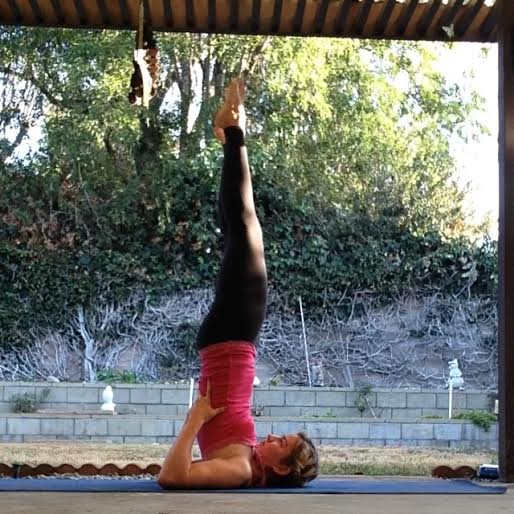It’s halfway through the practice. The sun salutations have risen and set, and being a fierce warrior has left your thighs and upper arms burning. The feeling of having worked hard is energizing but just on the cusp of transitioning into fatigue. Your drishti is starting to drift away from the fixed point four feet ahead of you as you balance precariously in bird of paradise toward visions of your dinner plate. The savasana-is-coming-soon part of yoga class is so close, and you know how good it will be.
The next sequence takes you all fours–that much closer to laying on your back, supine, a corpse. But no: Your instructor cues you up for a headstand. Suddenly, half the people in the room are struck with the need to use the bathroom, to take a drink or two of water, to fix their hair (even the men). Anything that will take up the better part of two minutes and save you from the hard–and scary–pose, salamba sirsasana.

Why anyone in their right mind would think it a good idea to put all your weight on the top of your head, gravity pushing you further down into a thin piece of foam, is a question even experienced yogis have at some point or another. Inversions like headstand are notoriously difficult and can take months–or years–to master, long after your limbs have been stretched and toned to new limits your pre-yoga self would have never thought possible.
Why is being upside down such a challenge? Because inversions force us to assume the exact opposite position of that for which our bodies are built (upright, erect, on feet rather than hands or forearms), they are inherently panic-inducing. Our equilibrium is off. Our view of the world is reversed.
I regularly take a Vinyassa level 2/3 yoga class that includes a whopping three headstands in the practice. It took me a good nine months for my reaction to those cues to progress from dread to enthusiasm. Recently, the instructor has been leading us in an interesting exercise that aims to speed that process along. Instead of having us lift up into the full pose, we go halfway (into a tuck position), then fall out of it.
Yes, we’re told explicitly to fall, three times in a row.
The fear of falling is perhaps the most succinct way to encapsulate what is wrong with being upside down. With most of your body suddenly above, rather than below, your heads, the point from which you process your sense of space and self through your senses and consciousness, you suddenly feel out of control and unable to hold yourself upright (or, rather, down-right). When you think you’re out of control, you are. And you fall–hard and fast into the unforgiving floor, maybe even into the person next to you.
This falling exercise, however, prompts you to making falling something that you’re in control of. It’s a deliberate movement, and therefore just a little less scary. After the first time, you see that falling isn’t so bad after all–yes, maybe it hurts, but you’ve been pushing your body to do things that are uncomfortable for the past forty minutes or more anyway. By fall number three, you’re no longer crashing to the ground like a tree at the mercy of a chainsaw but arching through the air like a gymnast. Eventually, you’ll be ready and eager to graduate to the next stage: not falling.
Conquering the fear of falling is an essential part of an inversion practice. Without mastering that mental step, your body will never be able to do what you want it to do. But once you clear out the space in your brain that was taken up by being scared, you’ll have that much more room to register being in an unfamiliar alignment–to embrace the sense of exploration and freedom that yoga aims to help you attain.
This skill is applicable off the mat, too. That’s not to say you should go about your day falling down or doing inversions. Rather, knowing that it’s okay to fall can open your mind like a massage does a tight muscle. You might have heard the idiomatic question “What would you do if you weren’t afraid to fail?” Falling with grace is a variation on this idea, for when you know that even if you don’t accomplish your goal the first time you can get up and try again you might push yourself a little more often. You’re comfortable with whatever the world will give you, right-side up or upside down alike.
Being accepting of the ways you can succeed and falter is one of the strongest attitudes with which to face life. It banishes the rigid expectations of perfectionism and the passivity of self-doubt. Striking the balance between the two will make you more human–a trait that not only helps you in the long run but will positively influence those around you. As renowned Broadway choreographer Bob Fosse once said, “I like . . . people who aren’t afraid to roll on the floor and make fools out of themselves.”
How to Master a Fearless Headstand:
1. Place your forearms on the ground and interlace your fingers in a fist so that both your pinkies are flat on the ground. Nestle the crown of your head into your hands. Walk into a short dolphin pose, balancing on your head. Hold this, being sure to lift out of your neck and shoulders by engaging your core.
2. Once you feel strong enough in your shoulders, play with raising one leg up into a tuck, with hips over shoulders. Try the other leg. You might alternate like this for several weeks or months, until you’re able to raise both legs and hold the tuck. Unlike forearm stand or handstand, never kick up into a headstand.
3. When you are comfortable balancing in the tuck, slowly straighten your legs in the air. Squeeze your ankles together to zip up your midline (and lessen wobbliness). You can facilitate this step by practicing against a wall, with your heels touching the wall as support. If possible, though, working through the steps away from the wall will prevent you from using it as a crutch–and if you’re not afraid you won’t need it!
Ta dah! You’re in headstand.
Also by Jen: Must-Buy Vegan Brand – Matt & Nat
Related: Therapeutic Yoga Poses for Menstruation
Yoga Sequence for Stronger Core
Photos: Anastasia Bailey




